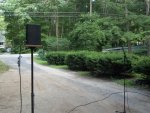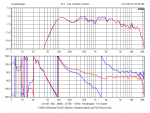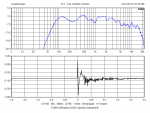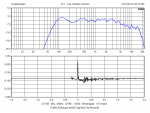Well, I still don't think I know the answer, but after an afternoon of playing around, I at least have a better idea. I know others have been doing this for a while, but I had never tried it for myself. I know that flat-phase tunings significantly improve impulse response and the overall sound quality of a speaker, and since I had some time to burn I gave it a shot.
So I threw an EAW JF60 up on a patented super-awesome custom measurement stand and put an Audix TM1 directly on-axis about ten feet away. Before I did anything else, I did a few basic EQ adjustments to get me to a relatively flat magnitude response.

Next, in Smaart, I ran the AutoSm feature to get me close and then adjusted the delay time manually until the phase was as flat as possible across the largest bandwidth possible. Turned out that the speaker itself was pretty flat right up until about 4k. Guess what? I bet that corresponds to the crossover frequency. Based on what I was seeing in Smaart, it seemed like the tweeter led the woofer by quite a bit, and by quite a bit, I mean about 360 degrees at 10k and nearly 720 degrees at 20k. Of course, measurements up that high are very sensitive to the mic moving, so even a slight breeze moving the speaker or mic stand could throw this off quite a bit. Fortunately, during my measurements, the phase stayed pretty solid so I think the measurements are pretty valid.
Before I started applying all-pass filters to the speaker, I played around with a direct FFT measurement of the amp (itech HD) output to see exactly what effect each type of filter had. Crown/BSS provides two types of filters, All Pass 1 and All Pass 2. I don't know all the technical stuff behind all-pass filters, but suffice to say that the All Pass 1 filter provided 90 degrees of delay at its frequency center with a very wide affected bandwidth. All Pass 2 seemed to provide much more phase shift at the center frequency, and the Q was adjustable, which was quite nice.
As I started applying filters to flatten the phase up high, I realized that every single time I adjusted anything in the DSP I had to correspondingly adjust the delay time in Smaart so I was seeing the phase there as flat as possible. It was very, very hard to make sense of anything when the phase was wrapping so much.
After applying 6 (yes 6!) all-pass filters at varying frequencies from 5k up to 15k, it was finally as good as it was realistically going to get. See the screenshot below for before and after phase traces. Purple trace is the after, white is the before. After my processing, the phase is flat to about 12k.

Listening to the speakers after, I really can't tell too much of a difference (at least not in the garage here). If I knew how to properly measure impulse response with Smaart I'd offer those plots, but I don't.
Edit, after doing some listening, the high end seems less hyped, in a good way. I like it.
So I threw an EAW JF60 up on a patented super-awesome custom measurement stand and put an Audix TM1 directly on-axis about ten feet away. Before I did anything else, I did a few basic EQ adjustments to get me to a relatively flat magnitude response.

Next, in Smaart, I ran the AutoSm feature to get me close and then adjusted the delay time manually until the phase was as flat as possible across the largest bandwidth possible. Turned out that the speaker itself was pretty flat right up until about 4k. Guess what? I bet that corresponds to the crossover frequency. Based on what I was seeing in Smaart, it seemed like the tweeter led the woofer by quite a bit, and by quite a bit, I mean about 360 degrees at 10k and nearly 720 degrees at 20k. Of course, measurements up that high are very sensitive to the mic moving, so even a slight breeze moving the speaker or mic stand could throw this off quite a bit. Fortunately, during my measurements, the phase stayed pretty solid so I think the measurements are pretty valid.
Before I started applying all-pass filters to the speaker, I played around with a direct FFT measurement of the amp (itech HD) output to see exactly what effect each type of filter had. Crown/BSS provides two types of filters, All Pass 1 and All Pass 2. I don't know all the technical stuff behind all-pass filters, but suffice to say that the All Pass 1 filter provided 90 degrees of delay at its frequency center with a very wide affected bandwidth. All Pass 2 seemed to provide much more phase shift at the center frequency, and the Q was adjustable, which was quite nice.
As I started applying filters to flatten the phase up high, I realized that every single time I adjusted anything in the DSP I had to correspondingly adjust the delay time in Smaart so I was seeing the phase there as flat as possible. It was very, very hard to make sense of anything when the phase was wrapping so much.
After applying 6 (yes 6!) all-pass filters at varying frequencies from 5k up to 15k, it was finally as good as it was realistically going to get. See the screenshot below for before and after phase traces. Purple trace is the after, white is the before. After my processing, the phase is flat to about 12k.

Listening to the speakers after, I really can't tell too much of a difference (at least not in the garage here). If I knew how to properly measure impulse response with Smaart I'd offer those plots, but I don't.
Edit, after doing some listening, the high end seems less hyped, in a good way. I like it.
Last edited:







